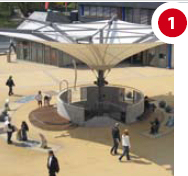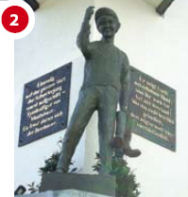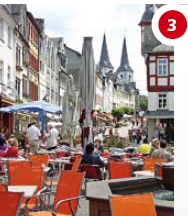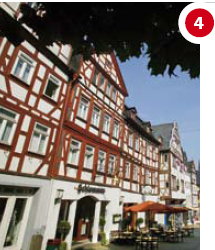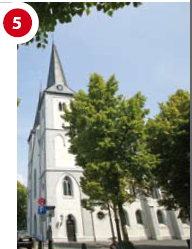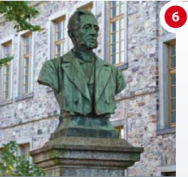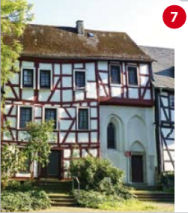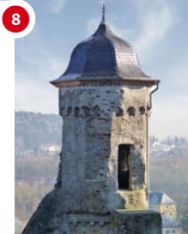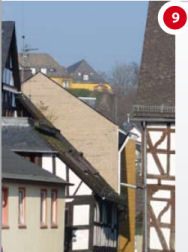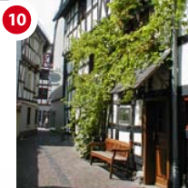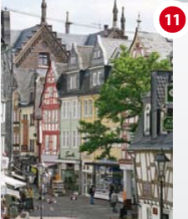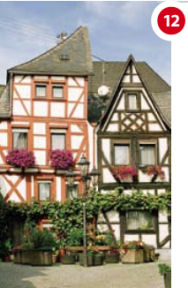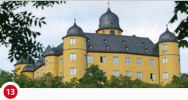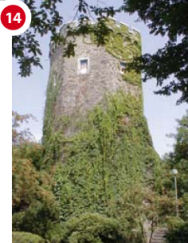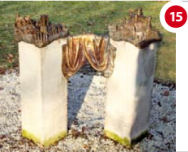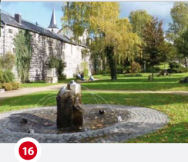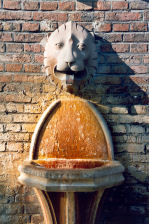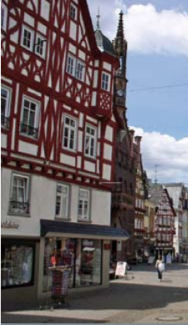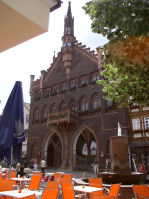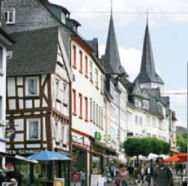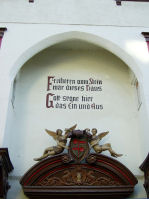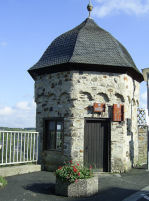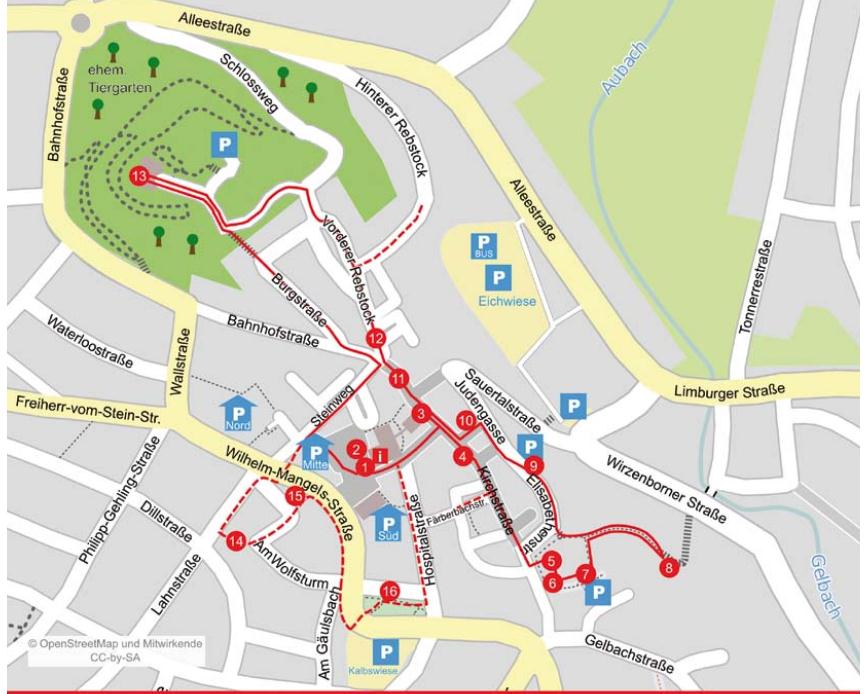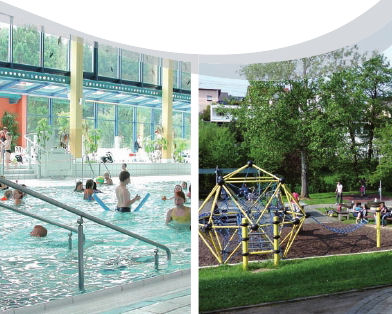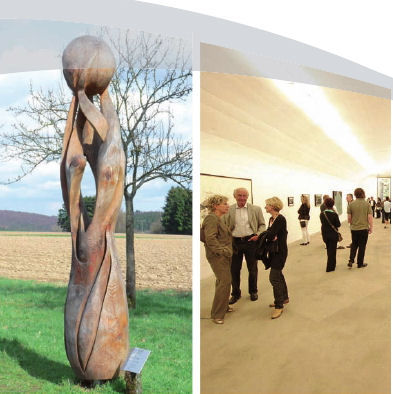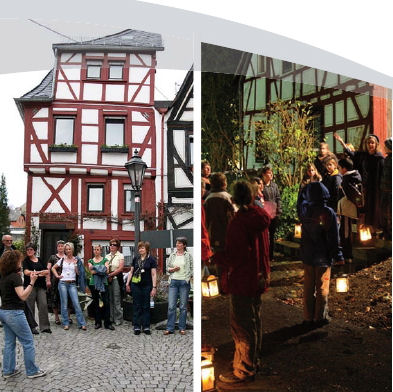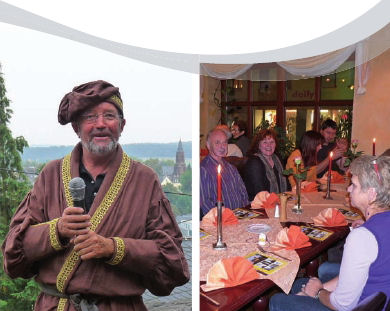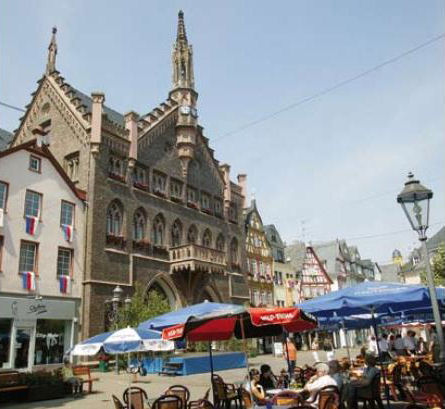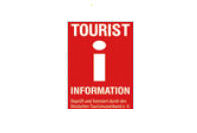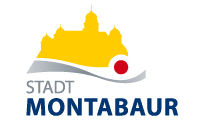Konrad-Adenauerplatz
(Konrad-Adenauer Square)
Over the years this modern square in
the heart of the town has been used
for a variety of purposes, including a
monastery garden and a fairground.
Today it is the site of the weekly
markets. Next to the Town Hall annex
there are shops, banks, restaurants and
cafés.
Schusterjunge
Cobbler’s Lad)
The figure on the front of thebuilding opposite the Town Hall
annex is doing what many citizens would like to do: on every quarter
hour he taps his forehead in the direction of the Town Hall, the German
way of suggesting they are not quite right in the head. The cobbler‘s
lad is a reminder of Montabaur’s shoe-making tradition.
Großer Markt
Great Market Square)
The town of Montabaur has always a held a strategic position on the main
trade routes. With the granting of a town charter in 1291 Montabaur also
gained the right to hold markets. Thus a foundation was laid for the development
of the town as the centre of the whole region. Today the weekly market
and several annual markets shape the town’s image.
Kirchstraße
Church Street)
The Kirchstraße is dominated by the half-timbered houses of
the old patrician families. The timbered frames are typical
of streets in the lower part of the central Rhineland. Most of
the houses here, like those in the Großer Markt and Kleiner
Markt, date back to the late seventeenth or early eighteenth century.
Katholische Pfarrkirche St. Peter in Ketten
(RC Parish Church St. Peter in Ketten)
This is the oldest church in the lower Westerwald region.
The first wooden structure of 940 was
replaced in 959 by a second church
on stone foundations, dedicated to
Saint George and Saint Peter.
Building on the present church was
started at the end of the 12th century
and completed in the middle of the
14th century. Later on it was repeatedly
refurbished and rebuilt as a
result of fires and structural damage.
The last complete refurbishment was in 2003.
Denkmal Joseph Kehrein
(Joseph Kehrein Monument)
The scholar and educationalist Joseph Kehrein, who had a decisive
influence on Montabaur’s education system was made a freeman of the town in 1873. He
came to Montabaur in 1855 as Dean of the Catholic Teacher
Training College and immediately embarked on an extensive
programme of education in Montabaur. To this day
Montabaur remains an important centre of learning for the whole region
Fuhrmannskapelle
(Waggoner’s chapel)
The former cemetery chapel is in the group of half-timbered
buildings next to the church. Also known as St Anna’s chapel,
it was built around 1300. The other buildings here, which
include the former rectory, were for a time used as a school for boys.
Stadtmauerturm Schwedenturm
(The Swedes‘ Tower)
The ”Gebück“ – the slope behind the church was the impregnable hedge
of thorns and brambles, which along with the Swedes’ Tower, was the
first line of the town’s defence fortifications. The tower originally
jutted out five feet from the edge of the precipice, delicately poised
over the sheer drop to the Sauertal below
Judengasse
(Jews‘ Alley)
The Jews of Montabaur lived in this street in the Middle Ages.
They left because they were persecuted after two outbreaks
of the plague in 1348 and 1348, for which they were blamed.
They later returned and settled around the Vorderer- und Hinterer Rebstock.
Werbhausgasse
(Recruiters‘ Alley)
The ”Zum Heiligen Geist “ Inn was first mentioned in1476.. Later in 18th
century, when offcers and nobles wishing to enlist soldiers for their
regiments stayed there, it became known as the Werbehaus: “Werben”
means to recruit, hence the name of the alley.
Kleiner Markt
(Small Market Square)
This is where the daily dairy market was held in the Middle Ages. It is
nicknamed the Trichter (funnel), as it is so narrow because of the overhanging
upper floor of the halftimbered building. The date on the
facade is 1682. The slate facades, typical of the region, are always found
on the weather side of the building.
Rebstock
(The Grapevine)
There is some evidence that Montabaur had its own vineyard at the
foot of Humbach Castle, which is one explanation for the name of this part
of the town. (Rebstock =vine). Up to the time of the Nazi persecution
many Jews lived in the Vorderer- und Hinterer Rebstock. They were often
merchants or cattle traders. Vorderer Rebstock 26 housed the
congregation’s prayer room until 1889 when a synagogue was built in the Wallstraße.
Schloss
(The Castle)
The yellow castle is Montabaur‘s most famous landmark and its impressive skyline and unusual colour it make it immediately
recognisable. The present baroque castle was built between 1687 and 1709. Since 1969 it has belonged to the German
Cooperative Bank Academy (ADG) and now houses a congress and conference centre as well as the ADG business school
Wolfsturm
(The Wolf Tower)
The Wolfsturm was probably built in the mid-14th century
and is the largest tower in the old town fortifications with a
height of 20 metres (66 feet). For many years this two-storey
tower was used as a prison. From 1628-31 men, women
and children were imprisoned here and tried for witchcraft.
Burgunderplatz
(Burgundy Garden)
Montabaur is twinned with Tonnerre in Burgundy. The
bronze sculpture combines the skylines of the two towns, thus
symbolising their multi-faceted, long-standing bonds.
Stadtmauer
(Town Wall)
Part of the old wall can still be seen in the heart of Montabaur. In summer the small public garden with the
“Frog fountain” is ideal for relaxing or a game of bowls. The garden and the wall are also used for exhibitions and
installations by local artists.
Sauerbrunnen
(Drinking Fountain)
The Lion’s head is a reminder of the original
role of Montabaur as a seat of justice. The
water in the fountain is drinkable but has
a sour taste because of the high content
of carbonic acid (2,000 mg/l) and iron.
The water is very healthy and particularly
effective in the treatment of a variety of
ailments.
Marktbrunnen
(Market Fountain)
The Market Fountain stands on
the site of an old well. On the central
pillar the 13 town gates and the
symbols of the 13 mediaeval guilds
are depicted. There is also an outline
of the history of the town. The
carvings on the wall surrounding
the fountain depict the town crest
along with those of the neighbouring
boroughs.
Haus Melchior
(Melchior House)
For many years (from 1589) this
building was an important inn.
In the middle of the 18th century
an internal family feud ended in a
case of manslaughter. Thereupon
– on the order of the prince – the
building was split into two, as you
can tell from the double gable and
the dividing wall on the ground
floor. The loft was probably used to
store the town’s salt reserves. The
Prince Bishops of Trier, under whose
tutelage Montabaur stood, held a
state monopoly on the salt trade.
Altes Rathaus
(Old Town Hall)
This imposing neo-Gothic redbrick
building was built in 1870. It is the third
Town-Hall on this site.
The town hall is also referred to as The
Red Lion – in the Middle Ages when
trials were held here the lion was a
symbol of jurisdiction. Today it houses
the mayor’s offce.
Kirchstraße 1
(1 Church Street)
The small half-timbered
house on the left is thought
to be the oldest in the town.
A wooden beam inscribed
with the date 1500 was
found during renovation works.
Kirchstraße 16
(16 Church Street)
The von Stein family, to whom the house belonged from
1678 to 1780, had the inscription painted above the baroque
doorway. The family – local aristocrats- did not live in the
house themselves but rented it to important offcials in the
Montabaur administration.
Stadtmauerturm Schiffchen
(Town Wall Tower)
Remains of the old town wall can still be seen in the Judengasse.
Apart from its military function, the tower was also used as a jail for
people who had committed minor offences.
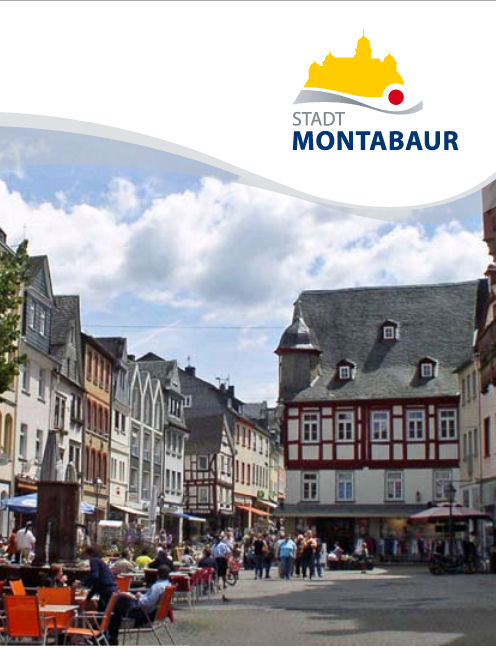
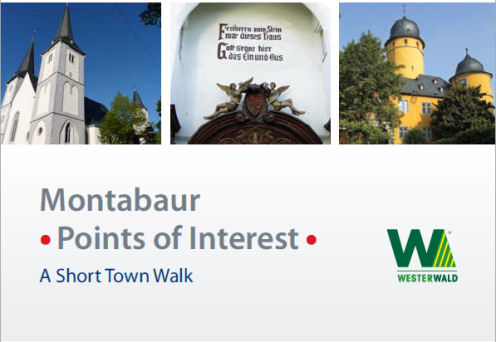
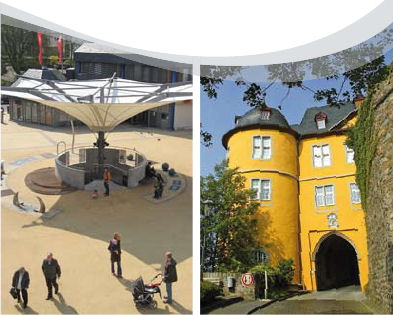
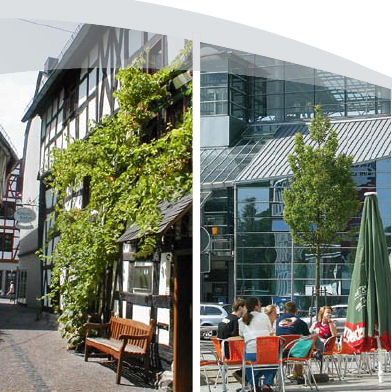
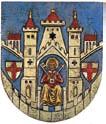 Town History
Town History